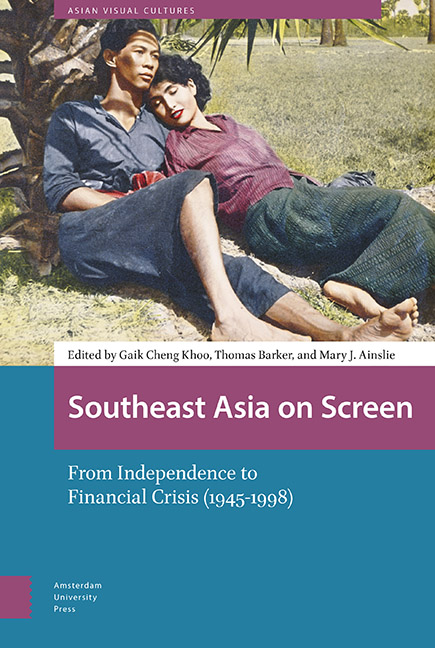Book contents
- Frontmatter
- Contents
- List of Illustrations
- Introduction: Southeast Asia on Screen: From Independence to Financial Crisis (1945–1998)
- Section 1 Independence and Post-World War II Filmmaking: Nation-building, Modernity and Golden Eras
- Section 2 Key Directors
- Section 3 Popular Pleasures
- About the Authors
- Index
Introduction: Southeast Asia on Screen: From Independence to Financial Crisis (1945–1998)
Published online by Cambridge University Press: 20 November 2020
- Frontmatter
- Contents
- List of Illustrations
- Introduction: Southeast Asia on Screen: From Independence to Financial Crisis (1945–1998)
- Section 1 Independence and Post-World War II Filmmaking: Nation-building, Modernity and Golden Eras
- Section 2 Key Directors
- Section 3 Popular Pleasures
- About the Authors
- Index
Summary
Throughout the last two decades, there has been a substantial increase in scholarly publications addressing Southeast Asian films and filmmaking (Ciecko 2006; Khoo 2007; Khoo and Harvey 2007; Lim and Yamamoto 2011; Ingawanij and McKay 2011; Baumgärtel 2012; Gimenez 2012; Chee and Lim 2015). Much of this is due to the phenomenal resurgence or revival of film production in the 1990s, beginning with art house films by Eric Khoo and Garin Nugroho, to be followed by younger filmmakers post-1998. The resurgence was the result of a combination of economic, sociopolitical and technological developments. First, the Asian Financial Crisis in 1997 affected economies in the region, with Thailand and Indonesia being hit the hardest with the devaluation of their currencies. Recession affected the region in varying degrees. Short of advertising work, Thai directors of commercials such as Pen-ek Ratanaruang and Nonzee Nimitbutr turned their hand to making feature films, many after returning from studying filmmaking abroad, so sparking the beginning of New Thai Cinema. In Indonesia, the financial crisis triggered sociopolitical unrest leading to President Suharto stepping down after 32 years in power. The end of the New Order era saw the end of restrictions and controls including the dismantling of a film apprenticeship hierarchy that had previously made it difficult for anyone in their 20s to be a director. Similar calls for ‘Reformasi’ and mass demonstrations not seen since the 1970s resounded in Malaysia in 1998 with the arrest and detention without trial of Deputy Prime Minister Anwar Ibrahim. The ending of authoritarianism in Indonesia and the radical spirit of reform infected young filmmakers in Malaysia and Indonesia who, with the added help of new technology (digital cameras), a ‘do-it-yourself’ sensibility and willing friends, began to make films cheaply and with fewer mental, infrastructural and bureaucratic restrictions.
The film revival coincided with developments in technology and the changing mediascapes (Khoo 2007; Lewis 2009; Hernandez 2012). Shooting on digital cameras and being able to edit on a laptop would herald the salvation of the moribund film industry in the Philippines, Vietnam, Cambodia and a decade and a half later, the nascent inklings of film production activities in Laos (e.g. Mattie Do's CHANTALAY, 2012), Myanmar and even Brunei, where two feature films have been produced and a film school, Mahakarya Institute of the Arts Asia, recently established (Brent 2019).
- Type
- Chapter
- Information
- Southeast Asia on ScreenFrom Independence to Financial Crisis (1945–1998), pp. 9 - 32Publisher: Amsterdam University PressPrint publication year: 2020



